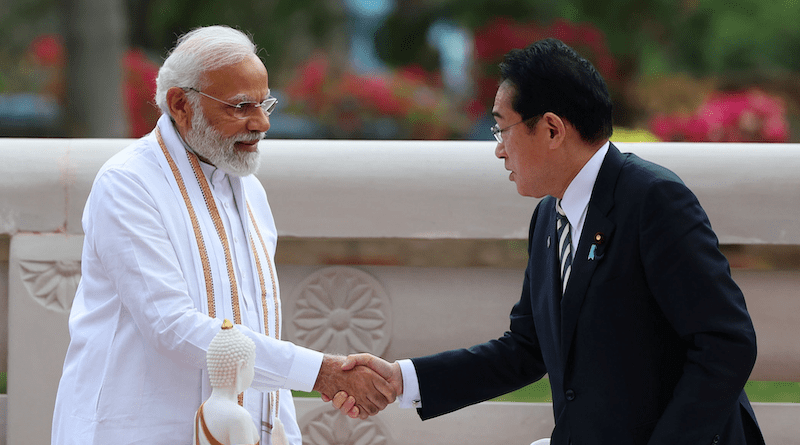The Importance Of Japan’s Prime Minister Kishida Visit To India – Analysis
By IPCS
By Dr. Sandip Kumar Mishra*
Japanese Prime Minister Fumio Kishida’s sudden trip to India on 20, 21 March 2023 was an out-of-turn visit as Indian Prime Minister Narendra Modi was supposed to go to Japan first.
Kishida’s visit is being seen as compensating for the absence of the Japanese foreign minister at the G-20 Foreign Ministers’ Meeting, which was held in India in early March. It is more likely however that this trip was meant to show sincerity on and commitment to the India-Japan friendship in the context of their diverging views on the Russia-Ukraine crisis.
India and Japan have seamlessly come closer to each other in the past two and half decades. The proximity grew further with the demonstrated personal connection between PM Modi and former Japanese PM Shinzo Abe, though goodwill for each other is bipartisan on both the sides. In this period, several bilateral issues, ranging from the economic to the strategic domain, brought them together. On regional and global issues also, both countries find mutuality in their interests and approaches. For example, both New Delhi and Tokyo are concerned about the rise of China’s ‘assertiveness’ and converge on the articulation of an Indo-Pacific strategy.
After the 1998 nuclear tests, which led Japan to impose sanctions on India, the Ukraine crisis poses the first serious challenge to the two leaders in maintaining the momentum of their relationship. Japan, under Kishida, has been quite overt in criticising Russia for its “aggression.” Following his India visit, Kishida made a surprise trip to Ukraine to meet Ukrainian President Volodymyr Zelenskyy. This was a remarkable visit as no Japanese prime minister has visited a war zone since the Second World War. Kishida wanted to “directly convey” Japan’s “unwavering support” for Ukraine and “resolutely reject Russia’s aggression against Ukraine.” Tokyo has already committed substantial aid to Kyiv—in February 2023, it pledged humanitarian aid of US$ 5.5 billion, which was four times more than its previous contributions.
Contrary to Japan, India has taken an ambivalent position on Ukraine. It has not used terms such as ‘Russian aggression’, although it has appealed for peace and a negotiated settlement of the crisis. The farthest India has gone in favour of Ukraine is PM Modi’s remark to Russian President Vladimir Putin that “it is not an age of war.” While the Quad countries and larger, US-led alliance countries have overtly taken pro-Ukraine positions, India is the only significant exception, with more economic and military exchanges with Russia in the past year than the previous era. Until now, India has abstained from voting on the Ukraine issue at UNGA twice. In the same period, India’s oil purchases from Russia has grown. Crude oil import from Russia between April 2022 and February 2023 was US$ 41.6 billion, as compared to the US$ 8.5 billion in the corresponding period of the previous year. This has led Russia to become India’s fourth largest source of crude oil imports.
It is thus quite obvious that India and Japan have clearly divergent approaches towards the Ukraine crisis. They have to tread forward carefully so their differing stances doesn’t affect their strong and comprehensive bilateral relationship. Both have to agree to disagree on this one issue, but continue to emphasise and work together on other areas of mutual interests.
This task however will become more challenging if the ‘one’ issue of disagreement becomes overwhelming, because the divide over Russia-Ukraine is going to shape the future global order and a crisis endgame is not yet visible. American, European and Japanese leaders have augmented their support to Ukraine, and a counter-network between Russia and China is also taking shape. This will definitely pose more pressing challenges to India-Japan relations, making it difficult to take bilateral engagement forward without being affected by their differences on Ukraine.
The good news is that both New Delhi and Tokyo are aware of this possibility. They have sought to keep their channels of communication open at various levels, and Kishida’s visit must be seen in this light. The challenge in maintaining their divergent positions while also retaining mutual trust is real and serious—how they walk the tightrope will shape the future of not only their bilateral relationship but also regional and global order.
*Dr. Sandip Kumar Mishra is Associate Professor, Centre for East Asian Studies, SIS, JNU, & Distinguished Fellow, IPCS.

